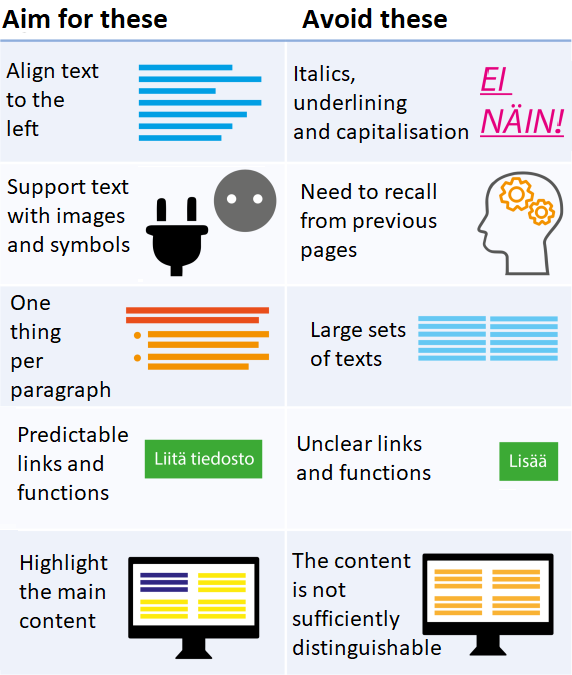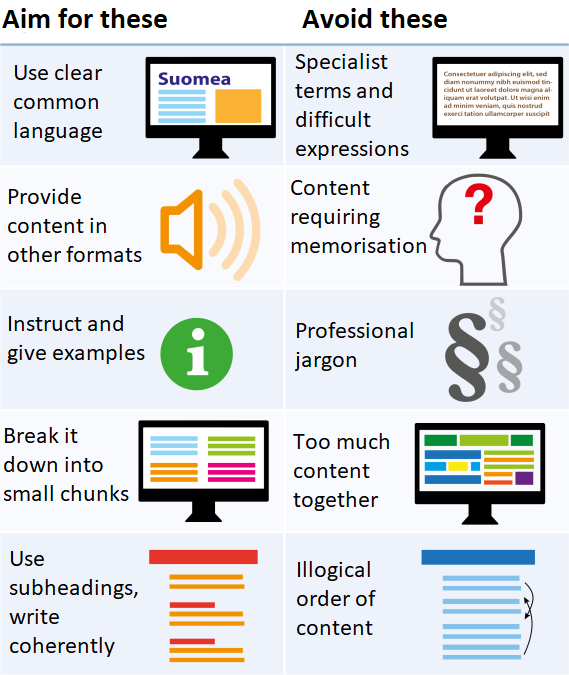Cognitive and linguistic limitations

Making perception easier
Cognitive and linguistic difficulties, as well as various learning difficulties, are a significant part of accessibility. Impairments make it difficult for people to understand the information that they receive and learn new things. Having an impairment makes it more difficult for people to understand things that they both read and hear.
You should note that such impairments do not necessarily affect the person’s intelligence. They are merely problems with the senses and perception.
Websites can take cognitive impairments into consideration by providing people with content in different forms. Taking cognitive limitations into consideration is not merely a question of content, but of other aspects of website design as well. Limitations must be taken into consideration so that using the website is as clear as possible. The user must not be disturbed unnecessarily with moving contents, changing images or content animations.
Because cognitive limitations can be related to vastly different difficulties with varying degrees of severity, there are many guidelines for taking them into consideration, each assisting some users in some capacity. There is no one universally suitable guideline.
Check at least the following:
- Use clear, understated colours.
- Use clear and good standard language.
- Avoid metaphors, figures of speech and difficult expressions.
- Align the text to the left, preferably in one column.
- Avoid using underscores, boldface and italics in texts.
- Do not write texts in all caps.
- The text is divided into short, clear wholes by using subheadings, lists, images.
- Do not express more than one thing in one sentence.
- Support the text with images, symbols, videos or audio recordings.
- Highlight the most significant contents of the page visually.
- The links and functions available to the user are informative and understandable.
- The contents are short and simple.
- If there are moving, changing or flashing contents on the page, the user can remove or stop all of them.
- The user is provided with tips and instructions so that all functions can be easily anticipated.

Linguistic limitations
The easiest way to prevent the effects of linguistic limitations is to use good content production and clear language. These limitations affect a very large number of users. Some users are placed in this group due to an illness or disability. However, the category also includes persons who have no diagnosed or diagnosable disabilities. People with a foreign native language require clear Finnish and benefit from clear language.
It has been estimated that there are roughly 500,000 people in Finland who need plain language. However, the number of people who benefit from contents presented in easy-to-understand language is considerably larger.
In reality, a very large proportion of native Finnish-speakers benefit from clear language. For example, the language used by public authorities or in public administration may contain terms and concepts that not everyone can understand adequately or in the same way.
The more difficult or important the information conveyed to people is, the clearer the linguistic expression must be.
If the reader misinterprets the content, the author is the one to blame!
Check at least the following:
- The contents use clear language and understandable expressions.
- Instead of administrative special terminology, the contents use standard language words.
- All the terms needed to understand the subject matter are explained at the beginning of the text or as the text goes on.
- The text explains one thing at a time.
- Matters are explained in a logical order.
- Matters are expressed briefly.
- The text uses lists and a clear paragraph division to clarify matters.
- Difficult matters are illustrated with examples.
- The contents feature images or charts that support the text and assist the reader.
- The text features a sufficient number of subheadings that are very indicative of the subject matter.
